What are the seven types of English adjective?

This is the third of five chapters about Adjectives. To complete this reader, read each chapter carefully and then unlock and complete our materials to check your understanding.
– Introduce the seven types of adjective in the English language
– Discuss important grammatical considerations for each type
– Provide examples of each type to help guide the reader
Chapter 3
Now that you’ve completed Chapters 1 and 2, you should hopefully feel more confident about identifying adjectives in the English language and understanding their various functions. This third chapter on the subject next aims to explore and exemplify the seven different categories of adjective that may be encountered either in every day speech or in academic writing. The following table briefly outlines the seven types of adjective that will be discussed in turn and in detail:
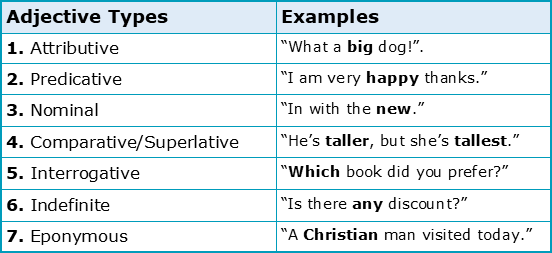
Type 1: Attributive Adjectives
One of the most common types of adjective is what’s known as the attributive adjective. As is shown in the four examples below, attributives are adjectives such as ‘tall’ or ‘red’ that modify a noun within a larger noun phrase (as the subject or object of a clause) such as ‘that tall gentleman’ or ‘the happiest people’.
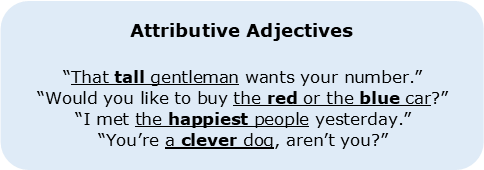
Notice that for each of these four examples, the adjectives ‘tall’, ‘red/blue’, ‘happiest’ and ‘clever’ within each noun phrase directly precede the nouns they describe. While it’s true that almost all such attributive expressions follow this syntactic structure, there are some attributive adjectives that do exactly the opposite. Postpositives, for example, are indeed a type of adjective that follows the nouns they describe when placed within certain constructions, as is shown in the four example expressions below:

Thankfully, it’s usually fairly easy to spot postpositive constructions such as these because postpositive adjectives almost always follow a particular type of noun. Notice in these four example expressions that the nouns used immediately before the postpositive adjectives are indefinite pronouns – such as ‘somebody’, ‘no one’, ‘nothing’ and ‘something’. Aside from constructions following such indefinite pronouns, the only other time you might encounter postpositive adjectives with any frequency is when set names and phrases require them, such as for the following:
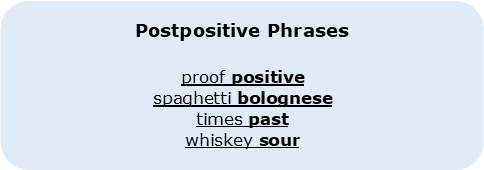
Type 2: Predicative Adjectives
Unlike attributive adjectives which most usually function within noun phrases as the subjects or objects of a clause, predicative adjectives in the English language are found within the complements that follow copula or other linking verbs. As is shown in the four examples below, linking verbs such as ‘be’, ‘feel’ or ‘seem’ that are able to take complements usually do so by including predicative adjectives such as ‘handsome’ or ‘quiet’:
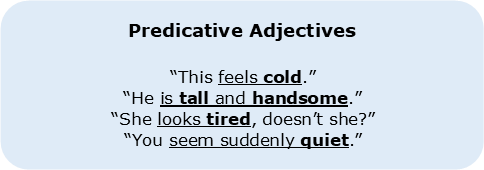
To further exemplify the syntactic differences between attributive and predicative adjectives, we’ve include a table on the following page that places two of our previous examples from each type into their respective phrase functions:

Type 3: Nominal Adjectives
Much less common than attributive and predicative adjectives are nominal adjectives. As the name suggests, nominal adjectives are those that function more like nouns than would be expected of an adjective. Only occurring within attributive constructions in which the adjective precedes the noun as part of the larger noun phrase, a nominal adjective is created when the head noun is elided (removed) from the construction, as in the following examples:
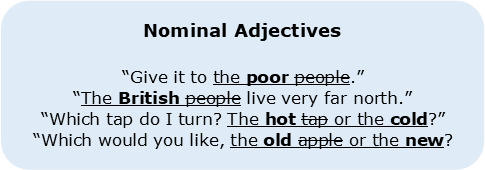
Please note that this type of adjective heavily relies on context and mutual understanding. Not only is this construction type fairly informal and infrequent, but only certain adjectives such as those exemplified may be used in this way.
Type 4: Comparative/Superlative Adjectives
As is explained comprehensively in our short course on comparative and superlative adjectives, some adjectives (those that are gradable in nature, such as ‘strong’ or ‘smart’) may be used to form comparisons within the English language:

As the previous expressions indicate, comparative and superlative constructions are formed by either adding the suffixes ‘-er’ or -’est’ to the relevant adjective or by preceding that adjective with the words ‘less/more’ or ‘least/most’ respectively.
Type 5: Interrogative Adjectives
The fifth type of adjective is the interrogative adjective. Only three adjectives in the English language have the function of interrogating (creating questions), and these are ‘what’, ‘which’ and ‘whose’. Like other types of attributive adjective, interrogative adjectives are used to modify nouns within noun phrases:

Type 6: Indefinite Adjectives
Formed from indefinite pronouns such as ‘anything’ or ‘nothing’ as mentioned earlier in this chapter, indefinite adjectives such as ‘any’, ‘many’ and ‘no’ are another type of special adjective in that they function much like the indefinite articles ‘a’ and ‘an’. Used to introduce or to discuss non-specific things, the following expressions each rely on the use of indefinite adjectives:

Type 7: Eponymous Adjectives
Finally, and fairly rare, are the eponymous adjectives which have been formed from the name of a real or fictional character, such as ‘Christian’ or ‘Confucian’ in the following two examples:

Having now discussed the seven different types of English adjective, Chapter 4 next explores some of the most important rules that govern their correct use.
Downloadables
Once you’ve completed all five chapters about adjectives, you might also wish to download our beginner, intermediate and advanced worksheets to test your progress or print for your students. These professional PDF worksheets can be easily accessed for only a few Academic Marks.
Collect Academic Marks
-
100 Marks for joining
-
25 Marks for daily e-learning
-
100-200 for feedback/testimonials
-
100-500 for referring your colleages/friends